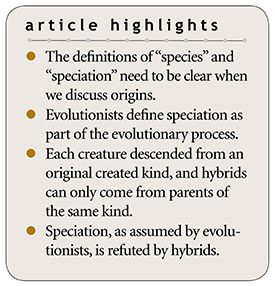 When investigating true-vs.-false controversies, words are very important. Yet Christians sometimes unintentionally perpetuate false teachings by using misleading terms that accommodate evolutionary assumptions.1,2 This is what law courts call confusion of issues, a truth-interference problem so serious that trial judges, invoking Evidence Rule 403, ban such confusing terminology when admitting trial evidence.3
When investigating true-vs.-false controversies, words are very important. Yet Christians sometimes unintentionally perpetuate false teachings by using misleading terms that accommodate evolutionary assumptions.1,2 This is what law courts call confusion of issues, a truth-interference problem so serious that trial judges, invoking Evidence Rule 403, ban such confusing terminology when admitting trial evidence.3
For example, the origin of species is a confusing topic. What exactly is a species? How can we properly analyze and discuss our origins if the words we use mean different things to different people? Consider this approach by Wikipedia, the multi-anonymous online encyclopedia that institutionally assumes evolution is scientific:
A species is often defined as the largest group of organisms in which any two individuals of the appropriate sexes or mating types can produce fertile offspring, typically by sexual reproduction.4
Members of a species breed within the same species. So far so good. But then Wikipedia gives it a Darwinian origin-of-species spin:
The evolutionary process by which biological populations evolve to become distinct or reproductively isolated as species is called speciation....Speciation depends on a measure of reproductive isolation, a reduced gene flow. This occurs most easily in allopatric speciation, where populations are separated geographically and can diverge gradually as mutations accumulate.4
So, the development of distinct, separate species is ground zero for the advancement of evolution. But this evolution-assuming speciation concept of gene pool split-offs due to geographic isolation, etc., has a recurring real-world problem—hybridization. Animals that are supposedly traveling on different branches of the same evolutionary tree shouldn’t be able to breed…but some do.
For example, in 2013, Norwegian bird-banders caught a surprise one day, a never-before-seen little bird now called a rødskvett (redchat, literally “red splash”). The name blends parts of the Norwegian words rødstjert (redstart, “red tail”) and buskskvett (whinchat, “bush splash”), which indicate its two parents.5 DNA testing confirmed this unlikely parentage.6
In English, that means a redchat bird is a hybrid, parented by a redstart with a whinchat. That also means that redstarts and whinchats are really the same species,7 according to Wikipedia’s opening definition. If redstarts and whinchats were different species, they couldn’t co-parent redchat hybrids.
The taxonomic surprise was not due to the birds’ genetics. The surprise was due to the evolution-assuming word “speciation” that ignored a simple fact. Namely, redstarts and whinchats do not represent an “evolutionary process by which biological populations evolve.”4 Instead, they are both descended from avian ancestors that God preserved in the Ark, and those came from a specially created kind that God invented on Day 5 of the creation week.8
God’s truth is better conveyed with clarity; only falsehoods benefit from smoke-and-mirrors deceptions. ![]()
God’s truth is better conveyed with clarity; only falsehoods benefit from smoke-and-mirrors deceptions. Yet, sometimes a term’s meaning, either its denotation or its connotation or both, changes so much that different terms need to be used to avoid distractions or other confusions.9
Bottom line: don’t fall for the evolutionary “confusion of issues” vocabulary trap!
References
- Johnson, J. J. S. 2012. What Good Are Experts? Acts & Facts. 41 (11): 8-10.
- Johnson, J. J. S. 2012. The Creator’s Glory Reflected Everywhere: True Treasure in the Cayman Islands. Acts & Facts. 41 (4): 8-10.
- Evidence Rule 403, which applies to both federal and state courts, permits a judge to identify misleading sources of confusion, including the distractive use of deceptive terminology, from being admitted into evidence.
- Species. Wikipedia. Posted on en.wikipedia.org. Although Wikipedia provides relevant information on many topics, it has a long track record of omitting or misrepresenting matters involving Genesis-based creation science.
- This unexpected hybrid is discussed in Spilde, I. Mysterious bird was unique cross of two unrelated species. ScienceNordic. Posted on sciencenordic.com March 11, 2015.
- See Hogner, S. et al. 2015. Intergeneric Hybridization Between Common Redstart Phoenicurus phoenicurus and Whinchat Saxicola rubetra Revealed by Molecular Analyses. Journal of Ornithology. 156 (3): 829-836, cited in Appleton, D. Common Redstart x Whinchat. Bird Hybrids. Posted on birdhybrids.blogspot.com January 13, 2016.
- Moreover, to the chagrin of taxonomic “splitters,” the whinchat is also known to hybridize with the Siberian stonechat and the Common stonechat of western and southern Europe, proving that those three chats descended from a common ancestral pair. See McCarthy, E. 2006. Handbook of Avian Hybrids of the World. Oxford: Oxford University Press, 238.
- Genesis 1:20-23.
- Consider Paul’s statement in Galatians 1:13, KJV: “For ye have heard of my conversation in time past in the Jews’ religion, how that beyond measure I persecuted the church of God, and wasted it.” The English noun “conversation” meant “behavior” 400 years ago, so Paul was referring to his walk, not his talk! To get Paul’s meaning today, the word “behavior” should be used, not “conversation.”
* Dr. Johnson is Associate Professor of Apologetics and Chief Academic Officer at the Institute for Creation Research.








